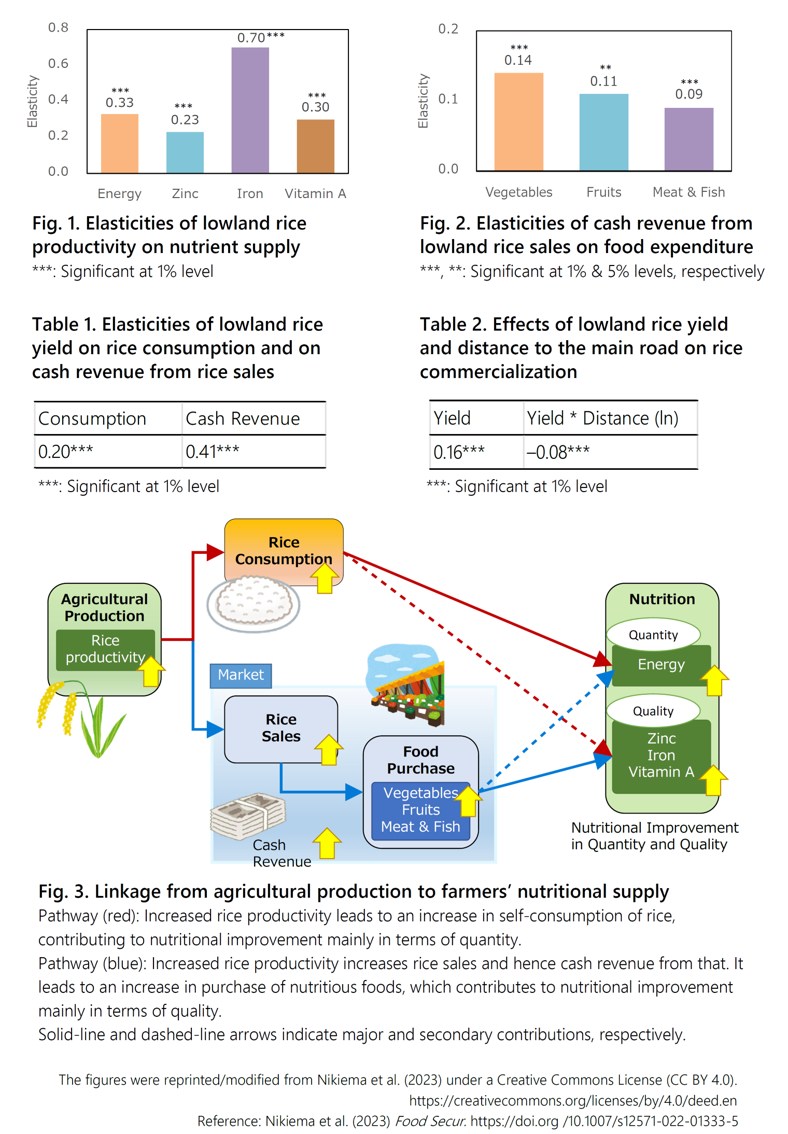Increased lowland rice yield improves nutrition of farmers in Madagascar
Description
Sub-Saharan Africa has the highest rate of hunger in the world, accompanied by serious micronutrient deficiencies. Since low agricultural productivity of staple crops is a major challenge in this region, increasing crop yield is urgently needed and expected to increase farmers' energy intake and cash income. Agriculture is said to have an effect on farmer’s nutrition; however, only a few studies have evaluated the impact of increased productivity of staple food crops on farmers' nutritional supply in rural areas of Sub-Saharan Africa. To explore the pathways and effects of lowland rice yield on farmers’ nutrient supply, we monitored the agricultural production and food consumption of 600 households over a three-year period from 2018 to 2020 in the rural areas of Madagascar, where rice is the main staple food.
We found that the elasticities of energy, zinc, iron, and vitamin A with respect to lowland rice yield are significantly positive (Fig. 1). Higher lowland rice yield increases the supply of these nutrients, for which deficiencies are particularly widespread in the target area. We also showed that an increase in rice yield leads not only to rice consumption but also to cash revenue from rice sales (Table 1). Increased cash revenue accelerates purchases of nutritious foods such as vegetables, fruits, and meat & fish at the market (Fig. 2). While yield has a significant positive impact on whether rice is sold (Yes/No), the interaction term of yield and distance to the main road has a significant negative impact (Table 2). Good market access promotes rice sales, suggesting the importance of the role that the market plays. This pathway is illustrated in Figure 3. In addition to increasing rice consumption (red line in Fig. 3), higher productivity of lowland rice increases purchases of nutritious foods through market channels (blue line in Fig. 3). Therefore, improving lowland rice productivity is effective in improving farmers' nutrition in terms of both quantity (energy supply) and quality (nutrition balance including micronutrients).
These findings contribute to the formulation and implementation of measures to improve nutrition by increasing the productivity of staple crops grown in rural areas of Sub-Saharan Africa. Technological interventions aimed at increasing the productivity of staple crops are effective in improving the nutrition of poor farmers and, in turn, SDG Goal 2 (Zero Hunger). This is the result of diversifying purchasing behavior through the market as well as through self-consumption, and it is necessary to ensure farmers' access to the market along with technology adoption.
Figure, table
- Research project
- Program name
- Term of research
-
FY2017–2022
- Responsible researcher
-
Shiratori Sakiko ( Information and Public Relations Office )
ORCID ID0000-0003-3285-3633KAKEN Researcher No.: 60746486Ozaki Ryosuke ( Social Sciences Division )
ORCID ID0000-0001-7152-8337KAKEN Researcher No.: 80965244Nikiema Relwendé Apollinaire ( University of Tokyo )
ORCID ID0000-0003-2625-4474Sakurai Takeshi ( University of Tokyo )
ORCID ID0000-0002-9007-4147KAKEN Researcher No.: 40343769Rafalimanantsoa Jules ( National Office of Nutrition, Madagascar )
- ほか
- Publication, etc.
-
Nikiema et al. (2023) Food Security 15: 823–838.https://doi.org/10.1007/s12571-022-01333-5
- Japanese PDF
-
2022_B09_ja.pdf1.15 MB
- English PDF
-
2022_B09_en.pdf623.73 KB
* Affiliation at the time of implementation of the study.

